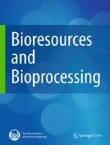Bioresources and Bioprocessing is associated with the State Key Laboratory of Bioreactor Engineering, East China University of Science and Technology.
A food-grade expression system for d-psicose 3-epimerase production in Bacillus subtilis using an alanine racemase-encoding selection marker
Food-grade expression systems require that the resultant strains should only contain materials from food-safe microorganisms, and no antibiotic resistance marker can be utilized. To develop a food-grade expres...











